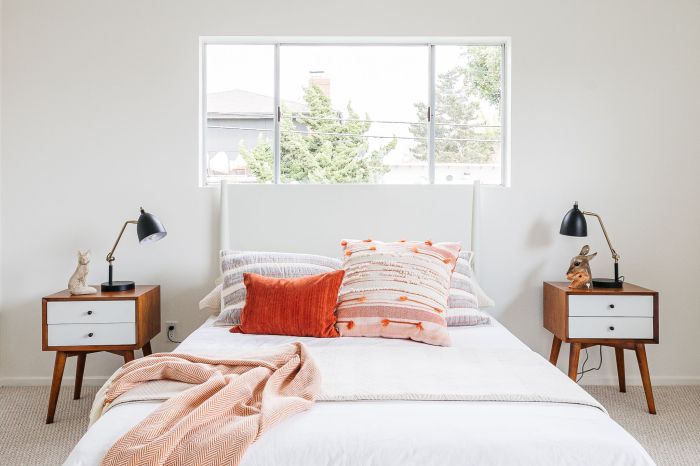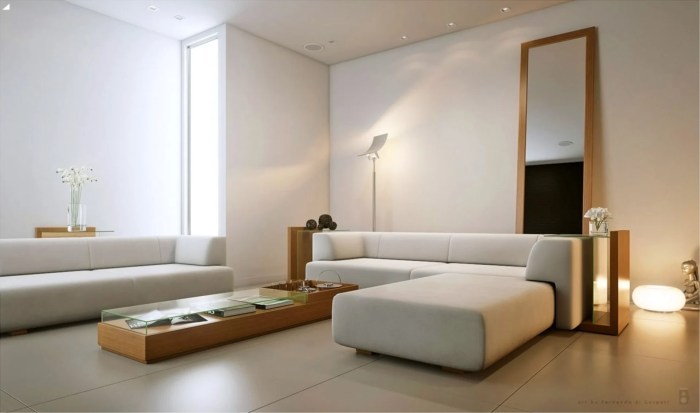Desain interior rumah minimalis – Minimalist interior design, far from being stark and cold, offers a pathway to creating a serene, functional, and stylish living space. It’s about curating a home that reflects your personality while prioritizing simplicity, intentionality, and a sense of calm. This comprehensive guide delves into the core principles of minimalist interior design, offering practical tips and inspiration to help you transform your house into a haven of understated elegance.
Understanding the Core Principles of Minimalist Design
Minimalism in interior design isn’t about deprivation; it’s about intentionality. It’s about carefully selecting items that serve a purpose and bring you joy, eliminating clutter and unnecessary distractions. Key principles include:
Decluttering and Organization: The Foundation of Minimalism
Before even thinking about décor, decluttering is paramount. Ask yourself: Does this item serve a purpose? Does it bring me joy? If the answer is no, consider donating, selling, or discarding it. Efficient storage solutions, such as built-in shelving, drawers, and stylish storage boxes, are crucial for maintaining a clutter-free environment.
This process might seem daunting, but the feeling of spaciousness and calm that follows is incredibly rewarding. Remember to regularly purge items to prevent clutter from accumulating again.
The Power of Negative Space: Embracing Empty Space, Desain interior rumah minimalis
Negative space, or empty space, is a crucial element in minimalist design. It allows the eye to rest and prevents the room from feeling overwhelming. Don’t be afraid of leaving some wall space bare or allowing for ample floor space. This creates a sense of airiness and spaciousness, making the room feel larger than it actually is. This is especially important in smaller homes or apartments, where maximizing space is crucial.
Neutral Color Palette: Creating a Calming Atmosphere
A neutral color palette forms the backbone of most minimalist interiors. Think whites, creams, grays, and beiges. These colors create a sense of calm and serenity, allowing other elements, such as textures and natural light, to take center stage. While neutral is key, carefully chosen accent colors can add personality without overwhelming the space. Consider incorporating pops of color through artwork, textiles, or plants.
Natural Light and Airflow: Enhancing the Space
Maximize natural light by keeping windows unobstructed. Sheer curtains or blinds can provide privacy while allowing light to filter through. Good airflow is also important for a healthy and comfortable living space. Consider using fans or opening windows to promote air circulation, especially in warmer months. These elements contribute significantly to the overall feeling of openness and serenity.
Multi-Functional Furniture: Maximizing Space and Efficiency
Choose furniture pieces that serve multiple purposes. A storage ottoman can double as seating and storage, while a sofa bed provides extra sleeping space for guests. This approach helps to maximize space and keeps the room feeling uncluttered. Look for pieces with clean lines and simple designs that won’t visually overwhelm the space.
Materials and Textures in Minimalist Design
While minimalism emphasizes simplicity, it doesn’t mean sacrificing texture or quality. The careful selection of materials can add depth and visual interest to a minimalist space.

Source: thespruce.com
Natural Materials: Bringing the Outdoors In
Incorporate natural materials like wood, stone, and bamboo to add warmth and texture. These materials create a connection with nature and contribute to a feeling of calm and well-being. Think wooden flooring, stone countertops, or bamboo blinds.

Source: mmminimal.com
Textural Contrast: Adding Visual Interest
While a neutral color palette is common, adding textural contrast can prevent the space from feeling flat. Combine smooth surfaces with rough textures, such as a smooth concrete floor with a woven rug or a linen sofa with a leather armchair. This adds visual interest without disrupting the overall minimalist aesthetic.
Incorporating Personal Touches
Minimalism isn’t about stripping away all personality; it’s about curating a space that reflects your individual style. Incorporate personal touches thoughtfully, ensuring they complement the overall aesthetic.
Statement Pieces: Adding Personality with Purpose
Instead of filling your home with numerous decorative items, choose a few statement pieces that hold meaning and reflect your personality. This could be a piece of artwork, a unique sculpture, or a family heirloom. These items will become focal points in the room, adding character without cluttering the space.
Plants: Bringing Life and Energy
Plants are a fantastic way to add life and energy to a minimalist space. They introduce natural elements, improve air quality, and add a touch of vibrancy. Choose plants that complement the overall color scheme and require minimal maintenance.
Lighting in Minimalist Design
Lighting plays a crucial role in setting the mood and highlighting architectural features in a minimalist space.
Layered Lighting: Creating Ambiance
Employ a layered lighting approach, combining ambient, task, and accent lighting. Ambient lighting provides overall illumination, task lighting focuses on specific areas, and accent lighting highlights features or artwork. This creates a warm and inviting atmosphere.
Natural Light: The Best Source
Maximize natural light by keeping windows unobstructed and using sheer curtains or blinds to control the amount of light entering the room. Natural light is the most flattering and energy-efficient option.
Minimalist Interior Design Styles
While the core principles remain consistent, minimalist design encompasses various styles.
Scandinavian Minimalism: Light and Airy
Scandinavian minimalism emphasizes light, airy spaces with a focus on functionality and natural materials. Think light wood, white walls, and simple lines.
Japanese Minimalism: Tranquility and Simplicity
Japanese minimalism prioritizes simplicity, tranquility, and a connection with nature. It often features natural materials, muted colors, and a focus on negative space.
Modern Minimalism: Clean Lines and Functionality
Modern minimalism features clean lines, geometric shapes, and a focus on functionality. It often incorporates metallic accents and bold, graphic elements.
Frequently Asked Questions (FAQ)
- Q: Is minimalist design expensive? A: Not necessarily. While high-quality materials can be costly, minimalism focuses on curating fewer, well-chosen items, potentially saving money in the long run.
- Q: Is minimalist design boring? A: Not at all! Minimalism allows for personality and creativity through thoughtful selection of items and the use of texture and color.
- Q: How do I declutter effectively? A: Start by categorizing your belongings. Then, ask yourself if each item serves a purpose or brings you joy. Donate, sell, or discard items that don’t meet these criteria.
- Q: What are the best colors for a minimalist room? A: Neutral colors like whites, creams, grays, and beiges are popular choices, creating a calm and serene atmosphere.
- Q: Can I have a minimalist style in a small space? A: Absolutely! Minimalism is particularly beneficial in small spaces as it emphasizes functionality and maximizing space.
Resources
- Apartment Therapy
-Offers numerous articles and guides on minimalist design and home organization. - The Spruce
-Provides comprehensive guides on various aspects of home décor, including minimalist design. - Architectural Digest
-Features high-end minimalist interior design projects and inspiration.
Ready to Embrace Minimalist Living?: Desain Interior Rumah Minimalis
Start decluttering today and begin your journey towards a more serene and stylish home. Remember, minimalism is a journey, not a destination. Enjoy the process of curating a space that reflects your personal style and brings you peace and joy.
FAQ Corner
What are some common mistakes to avoid in minimalist interior design?
Over-cluttering, even with minimalist items, is a common pitfall. Using too many colors or patterns disrupts the clean aesthetic. Forgetting adequate lighting can also diminish the space’s impact.
How can I incorporate personality into a minimalist design?
Choose unique statement pieces of furniture or art. Incorporate personal collections sparingly. Use texture and material variety to add visual interest.
Is minimalist design suitable for families with children?
Yes, with careful planning. Choose durable, easy-to-clean materials. Employ clever storage solutions to keep toys organized. Prioritize open spaces for play.
How much does minimalist interior design cost?
Costs vary greatly depending on the size of the space, materials chosen, and level of customization. It can be budget-friendly if you focus on essential pieces and DIY where possible.
